
How to Trigger Spawning in Central and South American Cichlids: Tips for Breeders
Share
If you've ever found yourself captivated by the vibrant colors and bold personalities of Central and South American cichlids, you're not alone. As a hobby cichlid breeder, there’s nothing quite like the thrill of watching a pair bond and seeing those first fry appear. However, achieving successful spawning isn’t just about luck—it’s about understanding the specific conditions that can encourage your cichlids to breed. Below, I’ll share my go-to methods for triggering spawning in these incredible fish, from adjusting water parameters to fine-tuning diet and light. Let’s dive into what it takes to create the perfect breeding environment for your Central and South American cichlids.
1. Temperature Tweaks for Optimal Breeding Conditions
One of the most effective ways to trigger spawning is by slightly raising the tank’s temperature. For Central and South American cichlids, try adjusting the temperature to a range between 78°F and 82°F. Many species respond to subtle changes in temperature as they would to seasonal shifts in the wild, signaling that it’s time to start breeding. For an extra push, consider slightly lowering the temperature for a few days, then gradually raising it to simulate the rainy season—a natural breeding cue for many tropical fish.
2. Lighting: Finding the Right Balance
Lighting can also play a role in triggering breeding behaviors. In the wild, cichlids experience changes in daylight hours and intensity, especially during the breeding season. While tank lighting is less variable, you can adjust your tank’s lighting schedule to encourage spawning. Try reducing the light period slightly, simulating shorter, “rainy season” days, then gradually return to a standard 10-12 hour cycle over a few days. Avoid overly intense light, as most cichlids prefer dimmer settings when breeding.
3. Water Parameters: Quality and Chemistry
Water quality is crucial to successful cichlid breeding. Central and South American cichlids often thrive in slightly acidic to neutral pH levels (around 6.5-7.5), though this can vary depending on the species. In addition, consider the following water parameters for breeding success:
- pH: Many cichlids prefer water that’s slightly on the acidic side during breeding. Aim for a range between 6.5 and 7.5, depending on the species.
- Hardness: Moderately soft to medium-hard water (5-12 dGH) is typically ideal, but it’s always worth double-checking your specific cichlid species’ preferences.
- Filtration: Ensure the tank is well-filtered but without strong currents, as many cichlids spawn in calmer waters. Using a sponge filter is a great way to keep water clean without creating too much disturbance.
4. Diet: Fueling the Breeding Process
Diet plays a critical role in conditioning your cichlids for breeding. In the weeks leading up to spawning, provide a high-protein diet that includes a mix of live or frozen foods such as brine shrimp, bloodworms, or daphnia. These foods mimic what they would naturally eat in the wild and can help bring out those vibrant colors and breeding behaviors. You can also supplement with quality cichlid pellets to ensure balanced nutrition. Feeding once or twice daily is typically sufficient, but avoid overfeeding, as poor water quality can inhibit breeding.
5. Tank Setup: Creating a Breeding-Friendly Environment
The tank setup can make a big difference in your cichlids’ willingness to spawn. Here are a few essentials to consider:
- Hiding Spots: Many cichlid species are territorial and require defined spaces in the tank. Use rocks, driftwood, and clay pots to create caves or hiding places where pairs can feel secure and “stake out” their breeding territory.
- Substrate: Some cichlids prefer to dig and clean a space in the substrate before spawning. Use a soft, sandy substrate if your species naturally exhibits these behaviors.
- Separation for Pairs: If you have a large tank with multiple cichlid pairs, consider sectioning off spaces or using dividers to reduce aggression. Breeding pairs can become especially territorial and benefit from their own designated areas.
6. Introducing the Fish: Letting Nature Take Its Course
Introducing your cichlids to each other carefully is key to avoiding aggression and ensuring they bond. Some Central and South American cichlids, like convicts and firemouths, are known to pair up easily. However, others, like Oscars, can be a bit pickier. Here’s how I introduce potential pairs:
- Quarantine First: Always quarantine new fish before adding them to the tank to prevent disease transmission.
- Observe Carefully: Introduce the potential pair with a divider initially and observe their reactions. If there are signs of aggression, give them a bit more time separated before trying again.
- Bonding Behavior: Watch for bonding behaviors like swimming side by side, flaring fins, or gently nipping at each other. Once you see these behaviors, you can safely remove the divider and let nature take its course.
7. Maintain Patience and Consistency
Above all, successful breeding requires patience. Some pairs may take longer to bond or feel comfortable in their environment. Keep up with regular water changes, provide a nutritious diet, and maintain stable tank conditions to keep them healthy and stress-free. Every cichlid species and even individual fish may have their own timeline, so consistency and observation are key.
Final Thoughts
Breeding Central and South American cichlids can be a rewarding experience for any aquarist. By fine-tuning elements like temperature, lighting, water parameters, diet, and tank setup, you’re creating an environment that closely mimics their natural habitats, making them feel secure and ready to spawn. Watching your cichlids exhibit their natural behaviors and, eventually, seeing those tiny fry in the tank is well worth the effort.
